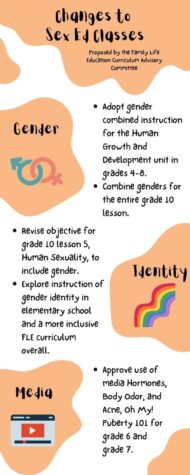Changes to FLE curriculum promote gender inclusiveness

Boys and girls being led to separate rooms during health class, followed by the speculations of what might take place in the other room. These might become customs of the past as school board members consider the newly proposed changes to the Family Life Education (FLE) curriculum in Fairfax County Public Schools (FCPS).
Originally recommended by the Family Life Education Curriculum Advisory Committee (FLECAC) in the 2021-22 school year, these changes mainly aim to promote gender inclusiveness by adopting gender-combined instructions, incorporating discussions on gender orientation and revising the instructional videos used in the curriculum.
“It’s good to have an educational conversation about what individualities, for lack of a better word, mean to people,” health teacher Brian Maslowski said. “Maybe part of the philosophy of including that is to educate people so that they can make greater decisions about those areas of their lives.”
One of the proposed changes is incorporating gender-combined instructions in the Human Growth and Development unit in fourth through eighth grade. All students will also receive instruction on the menstrual cycle unless opted out by their parents or guardian.
“All students should learn about menstruation because education on the topic removes the stigma against periods,” junior Thea Brown Hargrove said. “If everyone knows what a period is and why some people have one each month, people with periods can feel less embarrassed about their biology.”
FLECAC also recommended combining genders for the entire grade 10 lesson and removing the testicular self-exam video. Currently, students are separated into male and female groups for a small portion of the lesson, where female students receive instruction on breast self-awareness while male students receive instruction on testicular self-exam. This year, CHS has adopted gender-combined instructions for all aspects of the lesson.
“Taking sexual education classes together across genders once in high school is good because people feel confident that everyone is learning the same material,” Brown Hargrove said. “Once teens are mature enough to be together, they should be.”
For grade 10 lessons, FLECAC further suggested distinguishing the concepts of sex and gender, as well as recognizing that both the development of sexuality and gender as “aspects of one’s total personality.”
“There are lots of kids who are non-binary or gender queer, and a lot of the time if we don’t talk about it when we are young, we can go years feeling extremely uncomfortable and sad about our bodies,” junior Alex Monroe said. “Teaching about these things lets kids express themselves and understand who they are.”
FCPS provided a feedback form for comments regarding all the changes proposed to FLE classes from Oct. 31, 2022 to Dec.1, 2022. The school board will consider all submitted comments and vote on the recommendations. For more information, families can call the Office of PreK-12 Curriculum and Instruction, Health, Family Life, and Physical Education at 571-423-4550.
“The changes they are implementing are very good, but I also feel like it’s only the first step,” Monroe said. “They still have a long way to go to be extremely more inclusive, specifically around the topic of asexuality, because a lot of times in sex ed having sexual and romantic attraction is talked about as an inevitability, and I think that’s the next change they should consider.”
Your donation will support the student journalists of Chantilly High School. Your contribution will allow us to cover our printing and annual website hosting costs.

Sixuan Wu is a senior and the Online Editor of The Purple Tide. As a 1.5 generation immigrant, she enjoys learning about different cultural experiences....




